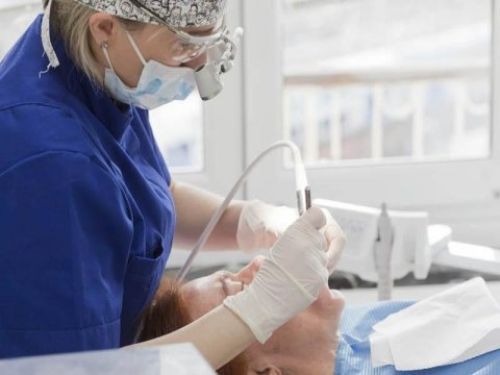Good oral hygiene, obtained by removing bacterial plaque (biofilm), is key for maintaining oral health.
A biofilm is an group of bacteria which stick to each other and to the tooth surfaces, which promotes and supports the common oral diseases: caries and periodontal disease.The deposition of calcium salts and phosphates through saliva turns them into tartar.
Biofilm is the primary cause of periodontal disease that, in its initial phase, manifests as gingivitis (inflammation of the gum tissue).
A good level of oral hygiene, achieved through effective daily brushing to remove the biofilm before it becomes tartar, has a key role in maintaining oral health, preventing periodontal disease and tooth decay.
The oral hygiene session involves the mechanical removal of biofilm (plaque) and tartar (which are the main causes of periodontal disease), and then cleaning around the oral cavity and reducing bacteria that are present.
Removal of soft deposits, plaque and food debris from the oral surfaces is important for the maintenance of dental and periodontal health.
Periodontal disease includes gingivitisand periodontitis.
Gingivitis is the reversible inflammation of the periodontal soft tissues, and presents with swelling, oedema, redness of the gingival margin and bleeding.
Periodontitis is the profound irreversible inflammation of the tissues surrounding the teeth, creating periodontal pockets between the gum and tooth, gum recession and loss of bone support.
Inflammationis the result of the body's response to bacterial accumulations on the surfaces of the teeth and as a result of complex mechanisms involving the response of the immune system, can cause serious local damage with negative effects on the patient's general health.
This emphasises the importance of periodic check-up visits as a preventative measure, agreed by the patient and the hygienist depending on the patient's state of health and taking into account what is suggested in the literature.
As a general rule, it is recommended that all patients have a hygienist appointment every 6 months to maintain health and check for any abnormalities before they can get worse (caries, periodontal pockets, gingivitis, etc.)
Patients with acute or chronic periodontal disease, however, should have hygienist visits every 3-4 months.
Patients who have had extensive dental implant surgery should have oral hygiene appointments every 3 months.
At our dental surgery, oral hygiene visits are with the dental hygienist and last about 1 hour.Every patient receives information and advice for maintaining oral hygiene at home.
Patients undergoing surgery must have an appointment with the hygienist prior to their surgery, in addition to their regular periodic visit, in order to minimise the bacteria present, to help tissues to respond effectively to the surgery, and for post-surgical healing.
We follow personalised guidelines based on a patients' general state of health, pregnancy and breast feeding, diabetes, chemotherapy and radiotherapy.
The oral hygiene session includes:
During check-ups, two bitewing x-rays are taken for a thorough check, and to catch any early caries that might be present.
Fluoride Prophylaxis
As seen in the current guidelines from the Italian Ministry of Health, (Nov.2013), caries prevention with fluoride is necessary for everyone.
By definition, topical fluoride prophylaxis describes all means by which fluoride is available in high concentrations to the surfaces of the teeth, providing a protective local effect; therefore, they are not meant to be swallowed. There are different means of topical administration that provide fluoride at high concentration (gels, toothpastes, mouthwashes).
The topical administration of fluoride is not to be confused with systemic administration through the intake of milk, vegetables and cheeses.The inability to verify the amount administered can lead to to fluorosis, especially at ages when teeth are developing. For this reason, we prefer topical fluoride administration.
Therefore, the purpose of prophylactic fluoride is to prevent the formation of caries, especially in those patients where the incidence is high. It also counteracts tooth sensitivity.
At our surgery, fluoride prophylaxis is performed after the hygiene session, by applying a fluoride-based gel into an applicator tray that is kept in the mouth for 5 minutes, after which the patient must not rinse, eat or drink for the next half hour.After removing the trays, the gel residues that remain make the fluoride dissolve in the saliva and allow it to continue to stick to the tooth surface.
This procedure can be carried out once a year on all patients as a preventive measure and above all it is recommended for those with a high risk of developing caries.
